Hal Jespersen's Battle of the Bulge Tour, December 2023
This is my (Hal‘s) report on my trip to Belgium and Luxemburg for a tour of the Battle of the Bulge, hosted by Stephen Ambrose Historical Tours. (And there is also some traveling in France before the start of the Ambrose tour.) It is my fourth tour with Ambrose, the first being the 75th anniversary of D-Day in 2019, followed by Patton’s advance across France and Belgium to Germany, then the Italian Campaign from Sicily to Rome in 2022, and then most recently, the World War I Western Front in November. Because this report is so large I have broken it into three parts:
- Part 1: Activities on my own before and after the Ambrose tour (Paris, Saumur tank museum, Brussels, Paris)
- Part 2: Northern Shoulder (Peiper, St. Vith, Spa, Belgium)
- Part 3: Southern Shoulder (Bastogne, Diekirch, Luxembourg) — this page
Maps
I created two maps to aid me through my travels. The first is of northwestern Europe, identifying important rivers and many place names that are relevant for the Ambrose tours I have taken. The second is the Ardennes region for the Battle of the Bulge, with the opening positions of the opposing forces. Clicking on either map will download the PDF version.


Friday, December 15 — Southern Shoulder, Bastogne
Another foggy, rainy morning, but by late morning it was just overcast. We started in Bourcy, where 2nd Panzer Division came through, bypassing Bastogne. We viewed a building still pocked with bullet holes, and talked about SD units following the army and murdering Belgian collaborators, eight here quite brutally. The village was mostly flattened during the counterattacks in January after the siege. Next stop was Noville, where Team Desobry of the 10th Armored Division set up roadblocks and took heavy casualties from the 2nd Panzer. We stood near Col William Desobry’s CP, where German artillery struck the building and wounded him, and killed Lt Col LaPrade of the 1/506th. There were eventually a number of 88s here, firing down the road to Bastogne.




We drove through Foy to the Bois Jacques and were disappointed to see that part of the E Co foxholes area is now fenced off by the Bastogne War Museum and requires a 20€ entry fee. We studiously avoided that indignity and followed a dirt trail back into the woods, where a number of 1st and 2nd platoon foxholes are accessible. Chris told us that often reenactors camped out in the area and re-dug them. There is commercial logging in the area, so the outlines of the woods are not exactly like 1944.



In the town of Foy we encountered a large group of modern 101st Airborne troops on a staff ride or tour. We walked to the building that is shown in the TV series where a sniper is shot by Shifty; repairs to the wall surrounding the window frame are apparent. Back in the woods, we found a large hole that was the battalion aid station and another nearby that was Capt Dick Winters’s CP. Then the jump-off point, Rue Madeleine, for the attack, which was much larger affair than shown on TV; E Co was attached to the broader 3rd Battalion attack, and the battle area is much larger than the TV viewer is shown. (And there was significant snow on the ground, sometimes thigh-deep, forcing soldiers to waddle instead of run in some places.) Chris also discussed the “Night of Hell,” the large artillery barrage shown so graphically on TV, and the background of Lt Dike, who was relieved in the attack, but had a more distinguished career than implied. Finally, Lt Spears, who despite what is shown on TV, was selected by Winters relieve Dike only because he was the first officer who came in view.




We visited the German cemetery, where 6,807 souls are buried, just a bit smaller than the Omaha US cemetery in a much smaller area. For the third graders in the tour, Chris pointed out an interesting pair of names on one grave marker. Then to the village of Rachamps, which E Co reached on January 16, to see the church where they experienced their first warm shelter in a month and heard the local choir sing to them, “As Seen on TV.” (Although I was told that the choir performed in the building across the street from the church.)



We drove back to Bastogne for lunch on our own. There is an M4A3(75)W Sherman from 11th Armored Division in the square with two noticeable holes in its armor. I fell in with a group who didn’t want a sit-down lunch, so I ended up with a protein bar and Chocolat Chaud Liégeois, which I selected based on its name, but turned out to have two scoops of vanilla ice cream in it, so was just luke warm, but yummy. Heading west on the Rue du Marché, we stopped across from a shopping center, which is where pathfinders from the 506th—the “Filthy Thirteen”—dropped in on December 23 to mark the location for airborne resupply. Across the street was the field where a battery of 333rd Field Artillery, a Black unit, supported the Bastogne defense, very accurately according to their white colleagues.



At Barrière-Hinck, we stopped at a big open field where McAuliffe stationed his field hospital west of town, and where the Germans overran the 326th Airborne Medical Company on December 19. As we’re becoming used to, atrocities occurred, including hospital patients with cut throats. In a field west of Château Rolley, we talked about attacks by the 26th Volksgrenadier Division on the western side of the US line. In our vicinity, the 502nd PIR was hit hard, but they were able to destroy 18 tanks and the line held. The 3rd Battalion, 327th Glider Infantry Regiment was also hit a bit west of where we stood.

Back to town, we stopped at the cemetery next to Bastogne Barracks, to which we plan to return on Sunday. We visited the graves of two civilian nurses who served during the siege, Renée Lemaire (the “Angel of Bastogne,” killed in the bombing of the aid station on December 24) and Augusta Chiwy. Both appeared in the TV show, although Augusta’s name was changed to Anna for some reason. And the aid station is not a church, but a building that is currently a Chinese restaurant. With waning daylight, we headed back to Clervaux. Dinner was on our own, and a group of six of us found a tapas bar down the street where I had a delicious dish of potatoes, sausages, and fried egg. It was accompanied by a high-level, intellectually stimulating discussion of military strategy, but some off-color jokes were exchanged.

Saturday, December 16 — Diekirch, Luxembourg
Today is the 79th anniversary of the start of the battle. It’s the first day of the tour with mostly clear skies, although that comes with a 32° temperature at 8 AM. (As a Northern California resident who does not ski, I believe this is the first freezing temperature I have encountered in over ten years!)
We started south of Bastogne at the Kessler farm, the site where on December 22 two officers from the Panzer Lehr Division approached the line of F Co, 327th GIR with a surrender demand, which resulted in McAuliffe’s famous reply, “Nuts.” (Starting today in Bastogne is “Nuts Weekend.”)

Heading southwest, we drove to Clochimont to examine Patton’s Third Army advance toward Bastogne. At a crossroads with a WWI monument, Chris talked about Lt Col Creighton Abrams and his exemplary record of over 50 tank victories, as well as how quickly he was able to plan and order a hasty attack north through Assenois to Bastogne on December 26. He sent forward a task force under Capt William Dwight with C Co, 37th Tank Battalion, and C Co, 53rd Armored Infantry Battalion. We followed his route as his tanks and halftracks barreled forward, spraying fire on both sides, unconcerned about his flanks. Approaching Assenois, seeing it was swarming with Germans, Dwight ordered a four-battalion artillery barrage followed by a sharp battle with house to house fighting. We drove through the town and witnessed buildings with visibly repaired damage from tank fire. The lead tank, Cobra King, an M4A3E2 Jumbo, commanded by Lt Charles Boggess, fired into a pillbox and then met up with the 326th Engineers, officially breaking the siege, although tenuously at this point. We stopped at the pillbox, which is now in a tiny memorial park with a Sherman turret and history plaques about the 4th Armored Division.



Then we drove an hour to Diekirch to visit the National Museum of Military History (Musée National d'Histoire Militaire). Along the way, Chris talked about the large scale movements of Third Army to reorient north, and Devers’s Seventh Army filling in the gap. This is my second visit to Diekirch, the first being with Ambrose in 2019, after the 75th anniversary of D-Day, as we followed Patton across Europe. It is a superb museum, with thousands of items, large and small. There are many dioramas with authentic uniforms and equipment, and I learned n 2019 that they usually interviewed each uniform owner to get his story and ensure the portrayal was accurate. They concentrate on Luxembourg, of course, in WWI, WWII, Korea, and with NATO, but the greatest emphasis is on WWII. They cover the 1940 German invasion, the occupation, the 1944–45 liberation, and a POW camp that a number of Luxembourgers suffered through. The nice Sherman out front is an M4A1(76)W HVSS, which they describe informally as an M4A1E8. I photographed only a tiny percentage of their displays, but you can infer how many high quality artifacts are available. I was particularly intrigued by a device called an Odograph, manufactured by IBM, which was used to drive around and create maps of the route and surrounding terrain, pre-GPS. There was also a model of a German "London Gun", or V-3, designed to lob artillery shells into London from the Pas de Calais. (Some of these photos are copies from 2019.) We had lunch on our own in Diekirch, where there are a surprisingly large number of Italian restaurants and pizzerias.

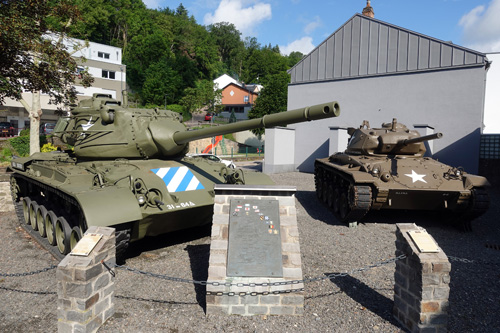
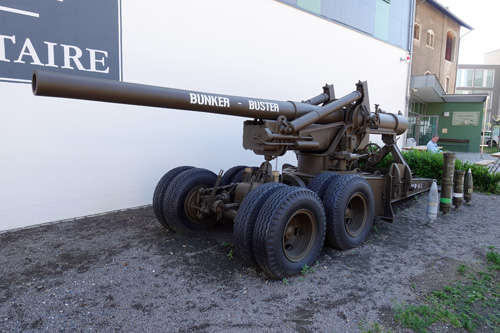

















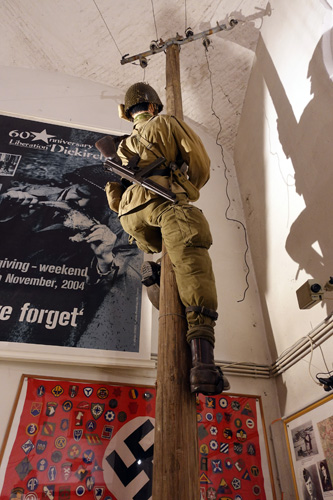

We drove to the American Cemetery in Luxembourg City, actually a close-in suburb called Hamm. I also visited here in 2019, although in considerably poorer weather, so again, some photos are repeated. I learned in 2019 that the cemetery holds the distinction of being the only one of the American European cemeteries that is in its original location. Patton’s staff bought the land at the start of the Bulge because the general knew a lot of casualties would be coming. Gen Patton was originally buried among the men of the Third Army, but he was later relocated to be at the head of his men’s formation. Bea Patton was offered the choice of burying her husband in the US, with Napoleon in Les Invalides, or with his men, and she did not hesitate deciding on the latter. (That was the explanation I heard from Kevin in 2019, but Chris offered an alternative theory.) The cemetery is beautiful, with impressive monuments and two large campaign maps. At 4 PM there was a brief military ceremony and US Ambassador Tom Barrett gave a speech. Afterward he walked by and chatted with a few of us, saying ambassadorial pleasantries.







We returned to Clervaux for another dinner on our own, this time back to the hotel’s Italian restaurant.
Sunday, December 17 — Bastogne and Brussels
We said goodbye to Clervaux in dense fog, but by the time we reached Belgium we found brilliant sunshine. We rushed to get to Bastogne Barracks before the Nuts Weekend crowds and enjoyed 1.25 hours visiting the armored vehicle displays and watching a few AVs motor around the vehicle restoration center parking lot. The two actual tanks were an M47 Patton an and replica of Cobra King, the M4A3E2 Jumbo that was famously “First in Bastogne.” The real Cobra King is displayed at the National Museum of the US Army, Fort Belvoir, VA.
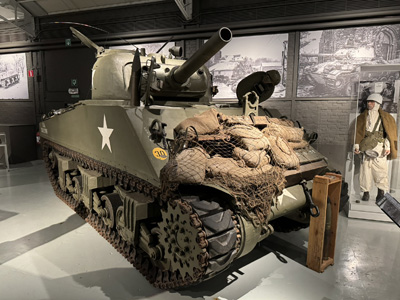
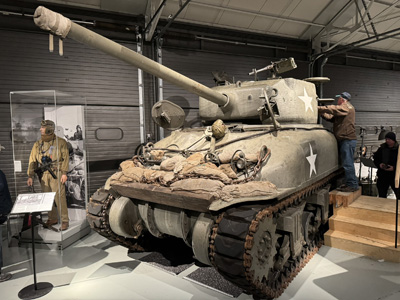
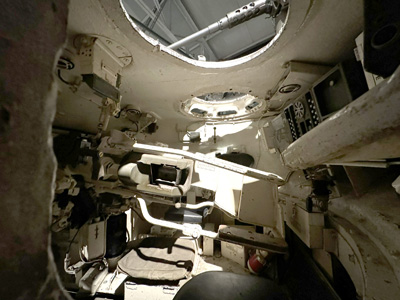
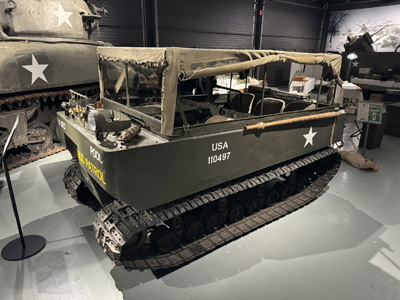
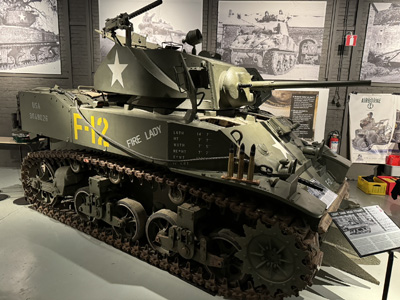
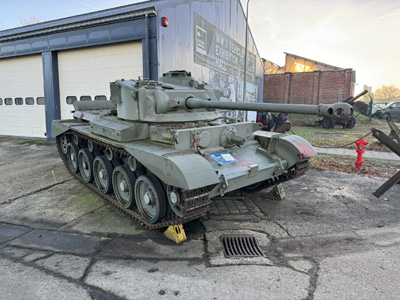

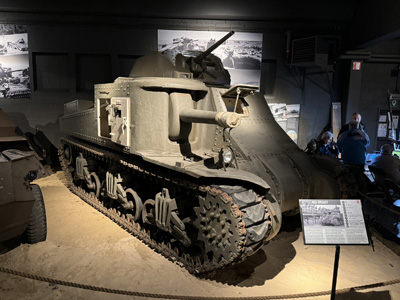
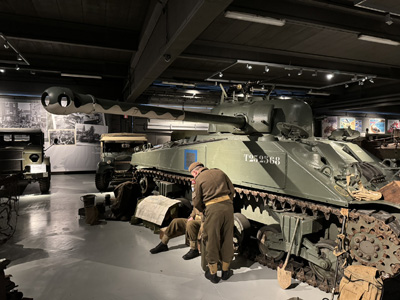
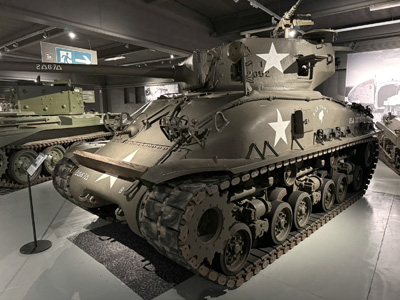
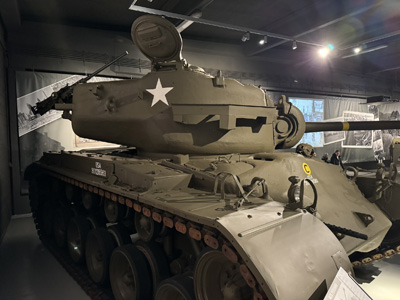
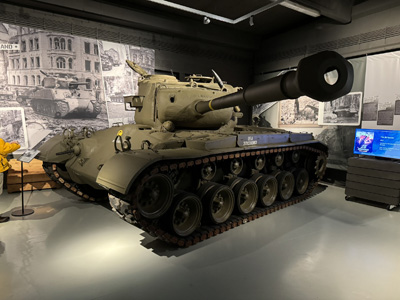
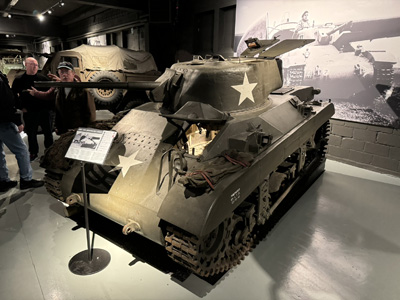
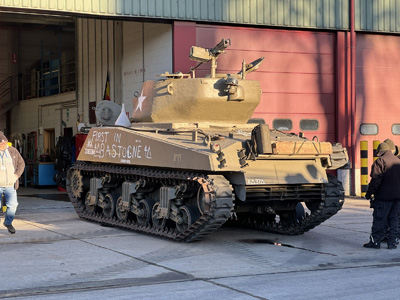
Nuts Day video:
There were a number of reenactors camped here for the weekend, both American airborne and Nazis. I came here in 2019 and we got to see more things, including inside said restoration center and the 101st Airborne Division HQ. They also had better lighting inside the tank buildings. (I talked to a guide from the War Heritage Institute, which manages this facility now, and he said the faint lighting was on orders from HQ in Brussels. Eurocrats, sigh.) Anyway, I have more photos from my 2019 visit here.

As we left Bastogne, I asked Chris whether we could visit the Mardasson Battle of the Bulge Memorial, but he said that it was closed for renovation. Here’s a picture from Wikipedia:

In the very scenic town of La-Roche-en-Ardenne, we stopped overlooking the Ourthe River at an M10 “Wolverine” Motor Gun Carriage, or tank destroyer. Chris emphasized that the battle was an Allied victory, not just American. It was here that Montgomery’s men, the 1st Northamptonshire Yeomanry, 51st Highland Division, met up with Patton’s Third Army on January 11, during the closing of the Bulge. We walked downtown to see a memorial plaque of the Blackwatch Regiment shaking hands with the 84th Infantry Division. We also saw an M4A1(76)W named Amboy, but the lighting wasn’t good and I think I have sufficient Sherman photos in this report.



Next was the nearby town of Hotton, where the Brits fought in 1940 and then there was north shoulder fighting between the 116th Panzer Division and the 3rd Armored Division on December 21. We visited the 660-grave Commonwealth War Graves Commission cemetery and Chris explained how they were created in WWI as a classless organization of burials. There was no repatriation option as the wealthier US had, and no private memorials. Some of the symbology and phrases used on altars and graves are attributed to Rudyard Kipling, whose son died in the Great War.

We had another baguette lunch on the bus and watched the 1949 movie Battleground, starring Van Johnson, corny in spots, but interesting because all the extras were 101st Airborne veterans. Chris said that before Band of Brothers came out, the soldiers of the 101st watched this movie every December 16. We drove to Celles, the farthest west point of the German offensive, actually not very far from the Meuse River. We stopped at a small brasserie called Le Tank, and it has a decrepit shell of a Panther out front. The 2nd Panzer Division fought here against the 3rd Royal Tank Regiment and the 2nd Armored Division (my old unit from 1971–72) on December 24. We saw their start at Dasburg, and here 125 km later, they got no farther, having run out of gas. A jeepload from Skorzeny’s commando force actually reached the Meuse at Dinant, where they were shot.

It was over an hour to our next/last hotel. We did a rest stop and the gas station had one of these gigantic windmills right next to it, so I checked it out:
Our final hotel is the Crowne Plaza Brussels Airport, which is quite comfortable. Our farewell dinner was a [really poor] buffet and everyone said they were pleased with the week. I had an excellent time, learned a lot, and met some great people. Chris Anderson was an outstanding historian/leader with an almost limitless memory for details and insight, George was an excellent tour manager and fun guy, and once again Klaas was an admirable bus driver, navigating some dicey roads with skill.
Go back to Part 1 for my return home via Paris.